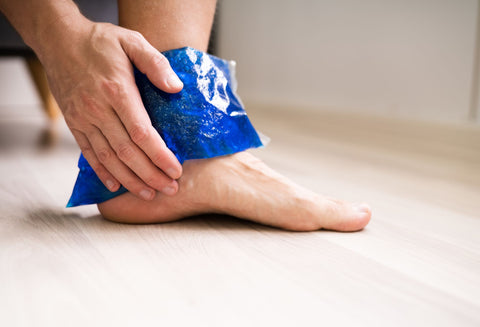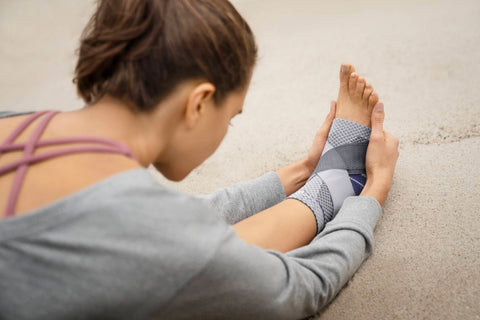Your Guide to Treating Ankle Tendonitis

Think you might have ankle tendonitis? You’re not alone. As an overuse injury, it’s pretty common, especially among those who do a lot of physical activity. The bad news is that ankle tendonitis (whether it’s Achilles, Posterior, Peroneal, or FHL) can range from mildly frustrating to nearly debilitating. But the good news is there are steps you can take to minimise symptoms and help your tendons heal. So, without further ado, here’s our guide to treating ankle tendonitis.
What is ankle tendonitis?
As we mentioned, ankle tendonitis is an overuse injury affecting any of the tendons in your ankle. Ankle tendonitis symptoms are largely similar across these tendons, but there are some differences.
Achilles Tendonitis affects the large tendon connecting your heel bone to your calf muscles. It’s the most common type of ankle tendonitis, usually caused by too much physical activity, tight calves, and overstretching the back of the ankle. Ageing and flat feet are also contributing factors. Achilles tendonitis symptoms include pain in the middle back of the ankle that gets worse with activities like running and climbing up the stairs. You may also see some redness and swelling and have difficulty flexing your foot.
Posterior Tibial Tendonitis affects the posterior tibial tendon, which runs down the back of the tibia near the Achilles and along the instep (arch) of the foot. This type of tendonitis is usually associated with flat feet. Along with swelling, pain, and redness, you may also have trouble curling your toes and standing on the ball of the affected foot.
Peroneal Tendonitis affects the tendons connecting the peroneal muscles to the ankle's lateral (outer) bony protrusion. Symptoms include redness, tenderness, swelling, and a ‘thickening’ of the tendon - sometimes feeling like a mass is moving alongside it.
Flexor Hallucis Longus (FHL) Tendonitis affects the tendon connecting the deep FHL muscles to the back of the ankle on the big toe side. It’s common among dancers and in sports requiring ‘push off’ manoeuvres like jumping. Generally, you’ll get pain and swelling on the ankle's back medial (inner) side. The tendon pain worsens when flexing your big toe, especially with resistance.
How to treat ankle tendonitis
RICE

According to an AFP study, RICE are key steps in ankle tendonitis treatment (along with protection and movement, but more on that later).
- Rest. Keep pressure off your affected ankle as much as you can for a few days. If possible, you should also avoid the activity that caused the injury until your doctor says otherwise.
- Ice. Apply an ice pack to the affected area for the first 3 days after you notice symptoms. Ensure you only apply an ice pack for 15 minutes a few times daily. You should also wedge a kitchen towel between the pack and your skin to prevent skin damage.
- Compression. Compressing the joint will boost blood flow to the area, moving old blood containing cellular waste out and new blood carrying oxygen and nutrients in.
- Elevation. When sitting or lying down, prop the affected ankle above heart level.
Get an ankle brace
Injured ankle tendons will need protection, which an ankle brace can provide. Just keep in mind that braces should always be made of quality materials, fit you perfectly, and be designed for your type of tendon injury.
The FHL and Achilles tendons will need a brace like the AchilloTrain Pro. It has a built-in heel wedge to relieve pressure on the posterior ankle tendons and sewn-in gel pads on either side to relieve pain. The brace is also made of our medical-grade compression knit, which will boost circulation and activate the muscles to help them better support the joint.
Meanwhile, the posterior and peroneal tendons will benefit from supports that limit pronation and supination, respectively. For minor cases, the MalleoTrain Plus will come in handy. Along with muscle-stabilising compression knit, it has a figure-8 strap for extra support. However, you may need to immobilise your ankle in more severe or chronic cases. You won’t have to get a moon boot, however. The CaligaLoc’s system of straps, comfort padding, and lightweight splints offer just as much support while still being able to fit into most shoes.

MalleoTrain Plus
Exercise
Pain and injury can make us reluctant to move. Though ironically enough, movement is crucial in pain relief and healing. When it comes to ankle tendonitis, you’ll need to focus on balance, strength, and flexibility. You could try the following:
- Calf raises. Stand upright and slowly lift your heels off the floor until you’re on your tip-toes, then lower them until they’re almost touching the floor. Repeat 15-20 times. These movements will strengthen the calf muscles, which are primarily responsible for supporting the ankle tendons.
- Ankle rotations. These will work to improve your ankle’s overall mobility. Sit on a chair, raise the affected leg off the floor, and gently rotate your ankle. Do so clockwise 10 times and anti-clockwise 10 times.
- Single-leg balance. This exercise will improve your ankle’s stability, helping you avoid damaging supination and pronation movements. To do this exercise, balance on the affected leg for 20 seconds, release, and then repeat another 2 times. Focus on an immobile spot, like a couch cushion, to make it a bit easier. To make it more challenging, close your eyes.
See more ankle mobility exercises: How to Restore Ankle Mobility After Injury
As always, speak with your physio to ensure you can start exercising without negatively affecting the healing process. Your physio can also provide a tailored exercise plan specific to your condition to ensure the best results.
A note on pain medication
Over-the-counter medications and ultrasound-guided steroid injections can provide pain relief. Many doctors recommend them for chronic and severe injuries. However, pain-relieving medication will mask your symptoms without addressing the underlying issue. In some cases, you might worsen the injury as your body can’t warn you about which movements are damaging or when you should get off your feet.
To sum up
Ankle tendonitis is an easy injury to get but not so easy to heal. But by protecting, resting, icing, compressing, elevating, and (later down the line) moving the joint, you can give your injured tendon what it needs to recover. Just ensure your brace is good for you and your injury, and don’t jump back into the action too fast.
If you require assistance selecting the right product for your needs or wearing the brace, call us on 1300 668 466 or contact us via live chat.
Do you have private health? Most private health extras will cover Bauerfeind Products. Check to see if yours is included. Bauerfeind Private Health Insurance Inquiry.


